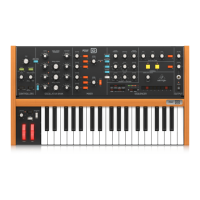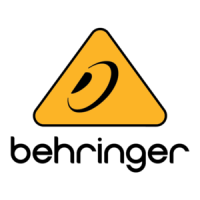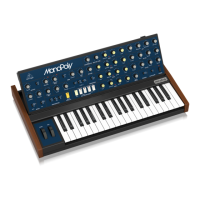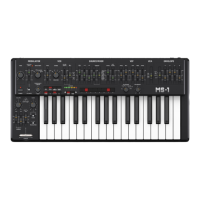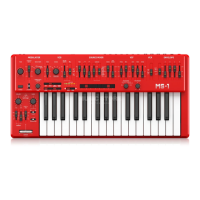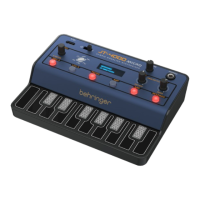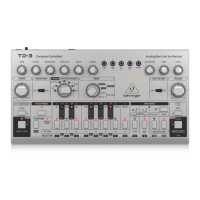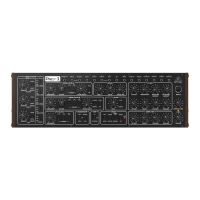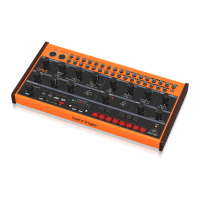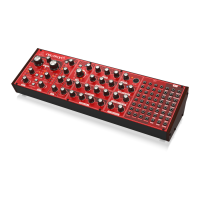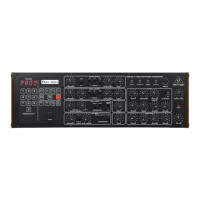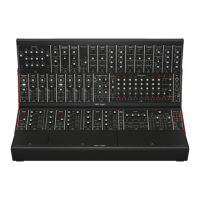39 MODEL D User Manual
Slew Rate: The rate of change of a voltage or control signal.
Spectrum: First used to describe the full range of colors in visible light, the term
is also used to describe the full range of frequencies in the audio spectrum.
Square Wave: A symmetrical waveform that combines an instantaneous rise
or fall, followed by a positive or negative steady state. The name comes from the
waveform's similarity to a square.
Step: A step is one stage in a sequence and can be a control signal, single note,
chord or rest.
Stereo / Stereophonic: The most common method of sound reproduction
where separate channels, left and right, are used to give the impression of
direction.
Stereo-Field / Stereo Image: A virtual space created by stereo
loudspeakers/monitors.
Sub-Bass: Frequencies in a signal ranging from 10 Hz to 60 Hz (lower than C0 to
approximately B1).
Subtractive Synthesis: A technique of creating sounds by ltering waveforms
which are rich in harmonics.
Sustain Level: The third stage of an ADSR envelope. Specied as "the level an
envelope will return to, after the decay stage". The envelope will remain at the
sustain level until the played key is held.
Sustain Pedal: A Pedal containing a switch which can be connected to a sustain
input and used to send a control signal dependant on the state of the switch (On/
O). The control signal can then be used to modulate other parameters, and/or to
add expression.
Synchronisation (Sync): Coordination of timing between devices.
Sync (Tempo): A function where an cyclical event such as an LFO is synchronised
to a tempo value.
Sync (Oscillator): A function where one oscillator is synchronised to another.
The waveform of the slave oscillator is reset whenever the waveform of the
master oscillator restarts.
Sync (Arp/Seq): A function where an arpeggiator or sequencer is synchronised
to a tempo value.
Sync (Key): A function where an event is synchronised to the pressing of a key.
System Exclusive (SysEx) Messages: Multi-byte messages used to transfer a
complete program or globals, in the form of request - response.
Threshold: Level at which dynamics processing will begin to operate.
Tempo: The speed at which a composition should be played, usually expressed in
beats per minute (BPM).
Threshold: In dynamic eects, this is the level that must be passed before the
processing is engaged.
Timbre: The tone, character, or aesthetic qualities of a sound.
Transposition / Transpose: A function that allows you to shift the entire
keyboard up and down in pitch.
Treble: Frequencies in a signal ranging from 5 kHz to 20 kHz (approximately D#8
to above C10).
Tremolo: A periodic change in amplitude.
Triggering: Activation of a function, such as the start of a note, envelope, or LFO.
Tune / Tuning: The process of adjusting the root pitch of the instrument to a
specic reference frequency.
Unbalanced Audio: A type of audio connection that uses two wires in a cable
and does not oer the noise rejection qualities of a balanced system.
Unison: Two or more voices that are playing together at roughly the same pitch.
Universal Serial Bus (USB): A "plug and play" interface that provides a fast
connection between a computer and peripherals.
Volt (V): A unit of electrical potential dierential or electromotive force. A
dierence in charge between two points in a circuit. This dierence, when
combined with the rate of the charge (current) allows for the control of many
analog circuits that “synthesise” sound.
VoltageControlledAmplier (VCA): An amplier whose resultant magnitude
is controlled by a voltage.
Voltage Controlled Filter (VCF): A lter whose cut-o frequency can be
controlled by a voltage.
Voltage Controlled Oscillator (VCO): An oscillator whose cut-o frequency
can be controlled by a voltage. Typically creates the possibility of tuning drift
when used in a synthesizer.
Vibrato: A periodic change in pitch.
Voice: A physical embodiment of a complete set of OSC, Envelopes, LFOs and VCF
which can play a single note.
Waveform: A repeating signal typically created by an oscillator. A waveform can
also be random in the case of noise.
Wavelength: The shortest distance between two successive points on a wave
that are in phase. When used in audio or acoustics, the physical wavelength is
calculated by dividing the velocity of sound in air (approximately 340 m/s) by the
waveform frequency.

